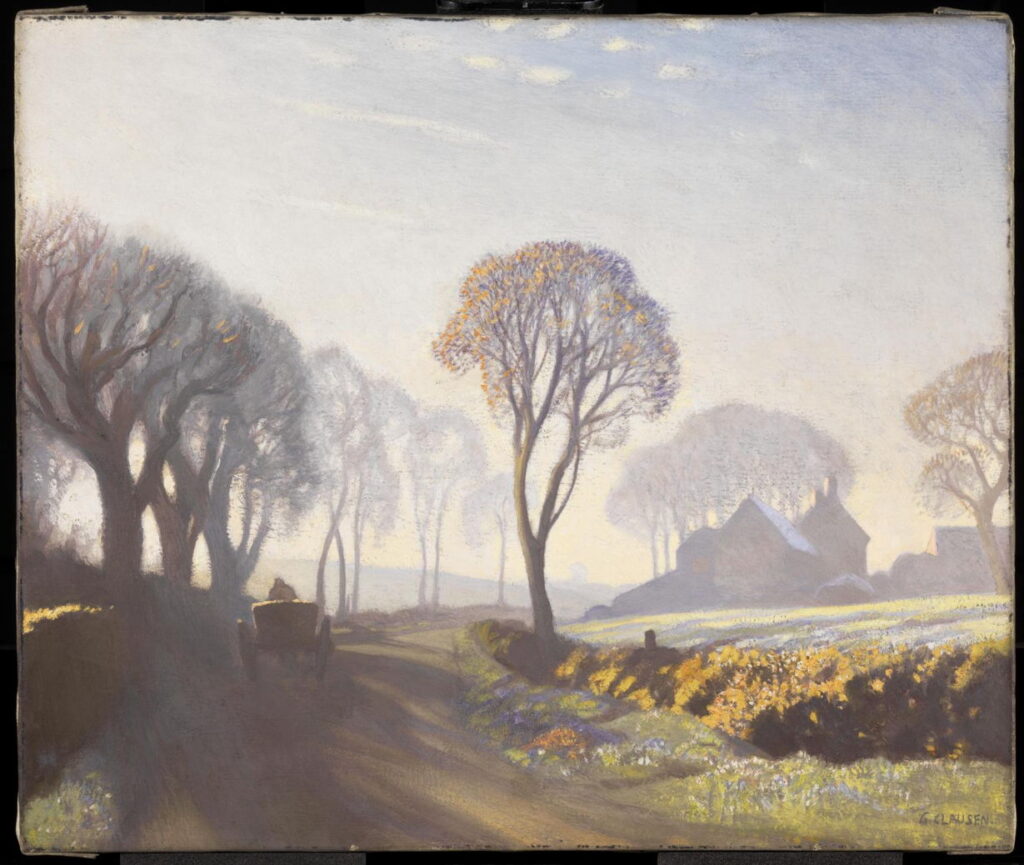Paintings of 1923: 4 Landscapes

In this, my last article showing paintings believed to have been made a century ago, in 1923, I venture beyond France, and show some of the rest of the world, from Norway to California.
Nikolai Astrup (1880–1928), Algiers (1923), pastel on paper, 65.5 x 50.8 cm, Private collection. Wikimedia Commons.
That year, the Norwegian artist Nikolai Astrup took a holiday in Algeria. It isn’t clear how many sketches and paintings he made during their trip overseas, but this pastel painting of Algiers suggests they’re worth locating. This shows Engel, his wife, staring out into the night from the verandah of their hotel in the city. Exotic palms are silhouetted against the lit buildings, and a row of hackney carriages awaits their customers.
Following their return to Norway, Astrup concentrated on painting the lyrical landscapes around the family smallholding at Sandalstrand, which was to be the focus of his work for the rest of his life.
Nikolai Astrup (1880–1928), Growing Season Weather (c 1923), oil on canvas, 79 x 99 cm, Private collection. The Athenaeum.
Growing Season Weather is a looser depiction of a part of Sandalstrand above the Astrups’ home. The artist’s wife and two of their children look intently at a steeply-sloping vegetable patch that will soon be harvested to feed their growing family.
Nikolai Astrup (1880–1928), Waterfall and Mill House (1923), oil on canvas, 64 x 95 cm, Bergen Kunstmuseum, KODE, Bergen, Norway. Wikimedia Commons.
Astrup’s Waterfall and Mill House shows half a dozen small huts for watermills dotted among the waterfalls high above Jølster Lake. Although the snows have gone from the hilltops, there is still plenty of water to drive those small mills.
Ants Laikmaa (1866–1942), Early Spring Landscape (1923), pastel on paper, 30.5 x 35.5 cm, Tartu Kunstimuuseum, Tartu, Estonia. Wikimedia Commons.
In early 1923, the Estonian pastellist Ants Laikmaa painted this farm in its Early Spring Landscape.
Lovis Corinth (1858–1925), Tree at Walchensee (1923), oil on canvas, 70 × 91 cm, Kunsthaus Zürich, Zürich, Switzerland. Wikimedia Commons.
Late in his career Lovis Corinth moved for much of the year to a mountain hut by the Walchensee in the Bavarian Alps. In the late autumn of 1923, he sketched the snowline of the mountains as it gradually descended, in his Tree at Walchensee.
Lovis Corinth (1858–1925), Walchensee in Winter (1923), oil on canvas, 70 × 90 cm, Städelsches Kunstinstitut und Städtische Galerie, Frankfurt. Wikimedia Commons.
A little later that year the snowline fell to the valley floor, and he painted Walchensee in Winter.
George Hendrik Breitner (1857–1923), The Rokin in Amsterdam (1923), oil on panel, 38 × 46 cm, Rijksmuseum Amsterdam, Amsterdam, The Netherlands. Wikimedia Commons.
In the Netherlands, George Hendrik Breitner painted one of his last works, The Rokin in Amsterdam, as he died in that city on 5 June 1923. Many of his photographs were not discovered until 1996, when it became clear how talented and innovative a photographer he had been. Oddly, his reputation has largely remained confined to the Netherlands, despite his involvement in the career of Vincent van Gogh and his importance as a social realist.
Sir George Clausen (1852–1944), The Road, Winter Morning (1923), oil on canvas, 50.8 x 61.0 cm, The Tate Gallery (Presented by the Trustees of the Chantrey Bequest 1923), London. Photographic Rights © Tate 2016, CC-BY-NC-ND 3.0 (Unported), http://www.tate.org.uk/art/artworks/clausen-the-road-winter-morning-n03824
Sir George Clausen’s painting of The Road, Winter Morning shows Barnard’s Farm, opposite Hillside, at Duton Hill, close to where he was living at the time, between Dunmow and Thaxted in rural Essex. Its mist and morning sunlight bring subtle colour.
Paul Nash (1892–1946), The Shore (1923), oil on canvas, 62.2 x 94 cm, Leeds Art Gallery, Leeds, England. The Athenaeum.
The young Paul Nash painted this starkly geometrical view of The Shore, showing sea defences on the coast of Kent, in south-eastern England.
For my final painting in this series, we cross the Atlantic and the continent of North America to California, where the great painter of New York’s skyscrapers, Colin Campbell Cooper, was visiting.
Colin Campbell Cooper (1856–1937), Terrace at Samarkand Hotel, Santa Barbara, California (c 1923), oil on canvas, 35.6 x 50.8 cm, location not known. Wikimedia Commons.
Terrace at Samarkand Hotel, Santa Barbara, California demonstrates Cooper’s sustained Impressionist style. This had originally been built as Boyland II School by Dr Prynce Hopkins in 1915, and was refurbished and opened as the Samarkand Hotel in 1920. Its buildings had a distinctive Persian appearance, with symmetrical gardens about this pergola. It was converted into a retirement community in 1955.



